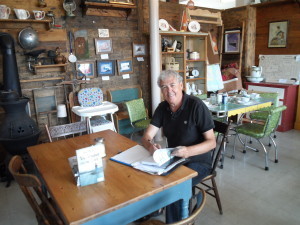Setting the Scene for a Good Story
by Mike Martin
I know you are not supposed to, but I do judge a book, at least whether I am going to buy it or not, based on the picture on the front of the book. That’s not my primary motivation to buy a book, but it can get my attention, attract me, and draw me in. I don’t think I’m alone in that. The front cover gives me an idea of where the book may be set, and sometimes that’s enough to get me to check out the blurb at the back and a little bit about the author.
Everyone has their own personal attractions, but for me and I think a lot of mystery readers we look to the front cover as a way to see inside the book. In my first two books I choose pictures from the area in which the stories take place, small fishing communities on Canada’s east coast.
Here is the cover from Book #1, The Walker on the Cape
As you can see it was a picture of the lighthouse in Grand Bank as seen, not from land, but from the ocean. We added a little fog and rays of sunshine coming through the clouds and the effect is stunning, IMHO. I had a 7 ft. banner done up with this cover on it and used it (still use it) at book signings and other promo events. Many people would come by just to look at the picture and ask where it was taken. Some of them even bought books!! For me the cover set the scene and the scenery made the sale.
But you can’t just put a picture of the ocean on the front and expect that people will rush to look at it and then buy your books. I learned this lesson from Book # 2, The Body on the T
Here is the cover from The Body on the T
[image error]
Another great picture, right? This time it is a boardwalk reaching out into the middle of the Atlantic Ocean. But somehow it didn’t attract people to come over and talk with me. That was too bad because I had a great story to tell them about when you walk out on this boardwalk in Burin, Newfoundland. It could be sunny when you start but some days the fog rolls in and you feel like you are completely surrounded by fog in the middle of ocean. But, alas, they didn’t come over to hear my tale.
Why? Who knows? A design friend of mine says it’s because the first picture is darker and more mysterious and thereby more attractive to mystery readers. The second book, he felt, was too bright and sunny. Maybe it didn’t set the scene right for the story that I wanted to tell or the story inside the book.
Inside my books, scenery and setting are crucial to the story. I have often joked that the weather is a character all to itself and in an ocean-side setting that is often the case. There’s always a little bit or a lot of wind, and almost always the threat of some form of precipitation. The small communities also have their own personality and character. That has been true ever since Jessie Fletcher showed up in Cabot Cove!!
Certain things can only happen in certain settings, although as fiction writers we do stretch that as far as our reader’s imagination will take us. For my books, the small coastal communities are tightly knit and full of secrets. My job is to pry them loose. I also have a responsibility to portray an authentic voice for both the setting and the communities. The words and actions of my characters are visitors to their world and I have to try and allow both to interact with integrity.
The final thing I would say about setting and scenery is that I try to only use places that I have actually seen or visited. Just for me, I think it would be hard to write about a librarian in the Deep South, although I admire those who do. And I do try and use all my senses to describe the setting, what it looks like, sounds like, smells like, feels like and sometimes even tastes like.
I think my mission as a fiction, mystery writer is to create characters who can fit into a real world. I can manipulate both them and their surroundings a little bit in the cause of a good story. But at The End, I want readers to say that both were believable. The best way for me to do that is to try and describe the scenery and the setting as accurately as possible, from my memory or imagination. And if I do that, I think I’m doing okay.
 Mike Martin is the author of the Windflower Mystery Series, set in small communities on the east coast of Canada. His latest book, The Body on the T, is now available in print and an e-book on Amazon.com
Mike Martin is the author of the Windflower Mystery Series, set in small communities on the east coast of Canada. His latest book, The Body on the T, is now available in print and an e-book on Amazon.com
The post Setting the Scene for a Good Story appeared first on Elizabeth Spann Craig.





